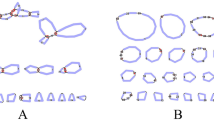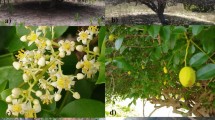Abstract
Octopus minor (Sasaki 1920) is an important commercial cephalopod species in China. This species has declined sharply in recent years. Hence, genetic studies of O. minor are imperative to exploit and manage the wild resource. In this study, 46192 microsatellite loci were discovered in 70174 unigenes from the transcriptomic data. Among all of the simple sequence repeat (SSR) unit categories, di-nucleotide and tri-nucleotide SSRs accounted for 45.26% and 14.49%, respectively. A total of 108 SSRs were tested, of which 21 were neutral and polymorphic. Seven SSRs were selected for genetics analyses of the O. minor populations in the Bohai Sea, the Yellow Sea, and the southwest coast of the Taiwan Strait region. Significant pairwise Fst values were detected among the samples. The UPGMA tree based on genetic distances suggested that the sampling locations could be arranged in three clusters. These markers are evidence that the populations in this region may be structured, with samples from Penghu differing remarkably from those in northern China. The present study characterized genetic markers for population assessment, management, and conservation of O. minor.
Similar content being viewed by others
References
Allcock, A. L., Lindgren, A., and Strugnell, J. M., 2015. The contribution of molecular data to our understanding of cephalopod evolution and systematics: A review. Journal of Natural History, 49(21–24): 1373–1421.
Barco, A., Raupach, M. J., Laakmann, S., Neumann, H., and Knebelsberger, T., 2016. Identification of North Sea mollusks with DNA barcoding. Molecular Ecology Resources, 16(1): 288–297.
Cabranes, C., Fernandez-Rueda, P., and Martinez, J. L., 2008. Genetic structure of Octopus vulgaris around the Iberian Peninsula and Canary Islands as indicated by microsatellite DNA variation. ICES Journal of Marine Science, 65: 12–16.
Chen, Z. W., Xu, R., Nan, Z., and Zheng, X. D., 2019. Determination of the median lethal concentration and acute toxicity of Octopus minor under different concentrations of ammonia and nitrogen stress. Oceanologia et Limnologia Sinica, 50(6): 1361–1370 (in Chinese with English abstract).
Doubleday, Z. A., Semmens, J. M., Smolenski, A. J., and Shaw, P. W., 2009. Microsatellite DNA markers and morphometrics reveal a complex population structure in a merobenthic Octopus species (Octopus maorum) in south-east Australia and New Zealand. Marine Biology, 156(6): 1183–1192.
Excoffier, L., and Lischer, H. E. L., 2010. Arlequin suite ver 3.5: A new series of programs to perform population genetics analyses under Linux and Windows. Molecular Ecology Resources, 10: 564–567.
Gao, X., Xu, R., Zhang, Z., and Zheng, X., 2019. Morphological variation analysis of Octopus minor in the coastal waters of China. Journal of Fisheries of China, 43(7): 1593–1602 (in Chinese with English abstract).
Gao, X., Zheng, X., Bo, Q., and Qi, L., 2016. Population genetics of the common long-armed octopus Octopus minor (Sasaki, 1920) (Cephalopoda: Octopoda) in Chinese waters based on microsatellite analysis. Biochemical Systematics & Ecology, 66: 129–136.
Guan, A., Wu, Y., Chen, Y., Sun, Y., Qi, P., and Guo, B., 2018. Deep sequence-based transcriptome analysis of microsatellites in the cuttlefish (Sepiella japonica). Progress in Fishery Sciences, 39: 144–151 (in Chinese with English abstract).
Kaneko, N., Kubodera, T., and Iguchis, A., 2011. Taxonomic study of shallow-water octopuses (Cephalopoda: Octopodidae) in Japan and adjacent waters using mitochondrial genes with perspectives on octopus DNA barcoding. Malacologia, 54(1–2): 97–108.
Kang, J. H., Kim, Y. K., Park, J. Y., An, C. M., and Jun, J. C., 2012. Development of microsatellite markers to genetically differentiate populations of Octopus minor from Korea and China. Molecular Biology Reports, 39: 8277–8286.
Kim, D. H., An, H. C., Lee, K. H., and Hwang, J. W., 2008. Optimal economic fishing efforts in Korean common octopus Octopus minor trap fishery. Fisheries Science, 74: 1215–1221.
Marshall, T. C., Slate, J., Kruk, L. E., and Pemberton, J. M., 1998. Statistical confidence for likelihood-based paternity inference in natural populations. Molecular Ecology, 7: 639–655.
Moreira, A. A., Tomas, A. R. G., and Hilsdorf, A. W. S., 2011. Evidence for genetic differentiation of Octopus vulgaris (Mollusca, Cephalopoda) fishery populations from the southern coast of Brazil as revealed by microsatellites. Journal of Experimental Marine Biology and Ecology, 407(1): 34–40.
Ni, L. H., Li, Q., and Kong, L. F., 2011. Microsatellites reveal fine-scale genetic structure of the Chinese surf clam Mactra chinensis (Mollusca, Bivalvia, Mactridae) in Northern China. Marine Ecology, 32(4): 488–497.
Oosterhout, C. V., Hutchinson, W. F., Wills, D. P. M., and Shipley, P., 2004. MICRO-CHECKER: Software for identifying and correcting genotyping errors in microsatellite data. Molecular Ecology Notes, 4(3): 535–538.
Pang, I. C., and Kim, K. H., 1998. Seasonal variation of water mass distributions in the eastern Yellow Sea and the Yellow Sea Warm Current. Journal of Korean Society of Oceanography, 3(3): 41–52.
Peakall, R., and Smouse, P. E., 2012. Genalex 6.5: Genetic analysis in Excel. Population genetic software for teaching and research—An update. Bioinformatics, 28: 2537–2539.
Perez-Losada, M., Guerra, A., Carvalho, G. R., Sanjuan, A., and Shaw, P. W., 2002. Extensive population subdivision of the cuttlefish Sepia officinalis (Mollusca: Cephalopoda) around the Iberian Peninsula indicated by microsatellite DNA variation. Heredity, 89: 417–424.
Rousset, F., 1997. Genetic differentiation and estimation of gene flow from F-statistics under isolation by distance. Genetics, 145: 1219–1228.
Scribner, K. T., Evans, J. E., Morreale, S. J., and Smith, M. H., and Gibbons, J. W., 1986. Genetic divergence among populations of the yellow-bellied slider turtle (Pseudemys scripta) separated by aquatic and terrestrial habitats. Copeia, 3: 691–700.
Seol, D. W., Lee, J., and Im, S. Y., 2007. Clove oil as an anesthetic for common octopus (Octopus minor, Sasaki). Aquaculture Research, 38(1): 45–49.
Shang, G. J., Xu, A., Hu, X., and Li, Z., 2019. Isolation and characterization of genic microsatellites from de novo assembly transcriptome in the bivalve Ruditapes philippinarum. Journal of Oceanology and Limnology, 37: 1071–1079.
Shaw, P., Pierce, J., and Boyle, P. R., 1999. Subtle population structuring within a highly vagile marine invertebrate, the veined squid Loligo forbesi, demonstrated with microsatellite DNA markers. Molecular Ecology, 8: 407–417.
Song, M. P., Wang, J. H., and Zheng, X. D., 2019. Prey preference of the common long-armed octopus Octopus minor (Cephalopoda: Octopodidae) on three different species of bivalves. Journal of Oceanology and Limnology, 37(5): 1595–1603.
Sun, B. C., Yang, J. M., Sun, G. H., Liu, X. Q., Liu, L. J., Wang, W. J., et al., 2010. Sequence and molecular phylogeny of mitochondrial COI gene fragment in five populations of Octopus variabilis in China. Oceanologia et Limnologia Sinica, 41(2): 259–265 (in Chinese with English abstract).
Sun, X., Li, D., Liu, Z., Zhou, L., Wu, B., and Yang, A., 2017. De novo assembly of pen shell (Atrina pectinata) transcriptome and screening of its genic microsatellites. Journal of Ocean University of China, 16: 882–888.
Tang, Y., Zheng, X., Liu, H., and Sun, F. G., 2020. Population genetics and comparative mitogenomic analyses reveal cryptic diversity of Amphioctopus neglectus (Cephalopoda: Octopodidae). Genomics, 112(6): 3893–3902.
Wang, J. H., and Zheng, X. D., 2017. Comparison of the genetic relationship between nine cephalopod species based on cluster analysis of karyotype evolutionary distance. Comparative Cytogenetics, 11(3): 477–494.
Wang, L., Yu, H., and Li, Q., 2018. Identification and characterization of 23 microsatellite loci for Chlorostoma rustica based on RAD-seq. Journal of Genetics, 97(1): 61–65.
Winnepenninckx, B., Backeljau, T., and Wachter, R. D., 1993. Extraction of high molecular weight DNA from molluscs. Trends in Genetics, 9(12): 407.
Xu, R., and Zheng, X. D., 2020. Hemocytes transcriptomes reveal metabolism changes and detoxification mechanisms in response to ammonia stress in Octopus minor. Ecotoxicology, 29(9): 1441–1452.
Xu, R., Bo, Q. K., and Zheng, X. D., 2018. A divergent lineage among Octopus minor (Sasaki, 1920) populations in the Northwest Pacific supported by DNA barcoding. Marine Biology Research, 14(4): 335–349.
Yamamoto, T., 1942. On the ecology of Octopus variabilis typicus (Sasaki), with special reference to its breeding habits. The Malacological Society of Japan, 12: 9–20.
Zhan, A. B., Hu, J. J., Hu, X. L., Zhou, Z. C., Hui, M., Wang, S., et al., 2009. Fine-scale population genetic structure of Zhikong scallop (Chlamys farreri): Do local marine currents drive geographical differentiation?. Marine Biotechnology, 11(2): 223–235.
Zheng, X. D., Qian, Y. S., Liu, C., and Li, Q., 2014. Octopus minor. In: Cephalopod Culture. Chapter 22. Iglesias, P., et al., eds., Springer, New York, 415–426.
Zuo, Z. R., Zheng, X. D., Yang, Y., and Li, Q., 2011. Development and characterization of 12 polymorphic microsatellite loci in Octopus minor (Sasaki, 1920). Conservation Genetics Resources, 3: 489–491.
Acknowledgements
We thank Associate Professor Mongfang Li (National Penghu University of Science and Technology) and Dr. Hae-Li Lee (Kunsan Seafood Company) for providing the specimens. This study was supported by the National Natural Science Foundation of China (No. 31672257), and the National Key Research and Development Program of China (No. 2020YFD0900705).
Author information
Authors and Affiliations
Corresponding author
Rights and permissions
About this article
Cite this article
Nan, Z., Xu, R., Hou, C. et al. Genetic Differentiation Among Populations of Octopus minor Based on Simple Sequence Repeats Mined from Transcriptome Data. J. Ocean Univ. China 21, 1265–1272 (2022). https://doi.org/10.1007/s11802-022-4944-z
Received:
Revised:
Accepted:
Published:
Issue Date:
DOI: https://doi.org/10.1007/s11802-022-4944-z




